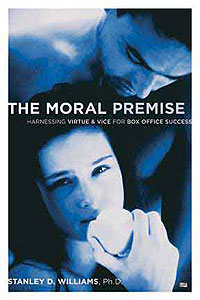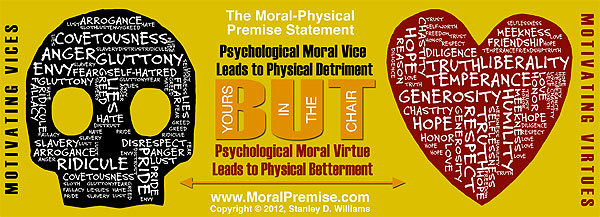
"The most powerful tool in my new tool box."
Will Smith
"A total game changer. The Moral Premise gets your story (and all your characters) working for you, instead of the other way around."
Michael Jann, Sr. Writer, Tonight Show with Jay Leno
"The Moral Premise dares to suggest that movies might actually mean something."
Chris Vogler, "The Writer's Journey"
"Thanks for the great book. I will recommend it to all my classes."
Blake Snyder, WGA, Author "Save the Cat"
"An incredibly practical and helpful tool that should be taught in every film school."
Marianne & Cormac Wibberley, WGA (National Treasure and National Treasure: Book of Secrets)
"Stan, You are a light and an incredible gift! Thank you for your insight and innovation.The Moral Premise: It's Amazing!"
DeVon Franklin, VP, Sony Entertainment
Author, "Produced by Faith."
"Should be required reading, retroactively, for every working Hollywood screenwriter."
Brian Bird, WGA, Producer
"Thank you, thank you, thank you for your wonderful Moral Premise, and for all you've done for me and my writing, Stan."
Tamera Alexander, Novelist
"This is really an important book."
Derek Rydall "The Script Doctor"
"Drop all of your 'to-do' lists, get this book, and curl up for the read of your screenwriting lifetime."
Dave Anderson, President, Compass Film Academy
Aspiring or working screenwriters - I have a tip for you. Buy the THE MORAL PREMISE by Stanley D. Williams and read it twice.
Paul Lalonde, Chairman, Cloud Ten Pictures
"More than a must-read; it is groundbreaking."
Curt LaLonde
More Endorsements >>
|
Moral Premise Mug Graphic
Below is a discussion of the Moral Premise Mug graphic depicted below that appears on our mugs. CLICK HERE to see the mugs and other writing-aids.
You can order this mug (with white, mustard, green, or blue background) at the
Moral Premise Story Shop.

PURPOSE.
With this mug at your side you'll be reminded of the arc that every main character in your story must take, if your story is to connect with audiences and succeed at the box office.
VICES vs VIRTUES.
At the far left of the graphic are the words "MOTIVATING VICES," which labels the weaknesses and vices collaged in the skull graphic. At the far right of the graphic are the words "MOTIVATING VIRTUES," which labels the strengths and virtues collaged in the heart graphic. The skull and the heart represent the extremes of values that motivate us and our characters. (By the way, these graphics were created at https://www.imagechef.com/ic/word_mosaic/ and downloaded as 800x800 pixel gifs.)
MOTIVATING VALUES.
It is the psychological moral values of a person (real or fictional) that motivate their every action. EVERYTHING your characters do must begin with their embrace of a value located somewhere on a continuum from the darkest evil to the brightest virtue.
Notice the double headed arrow near the bottom. That's to remind you that a characger can arc in either direction. You/he/she chooses; and then natures chooses, too.
THE STATEMENT.
Sandwiched in the middle of the skull and heart graphic is The Moral-Physical Premise Statement formula, described thoroughly in The Moral Premise and the many essays, blogs and other related websites. In short, the formula describes the arc for every main character in your story, along each of the character's multiple story lines. (Your protagonist will have multiple story lines dealing with various aspects of his or her life -- e.g. personal, professional, love, family, school, best friend, worst enemy, government, God, aliens. One of those story lines will be the main physical spine of the story.)
Thus, each characgter's storyline will move to some degree from being motivated one of two ways: Either from vice to virtue, or virtue to vice. And the original motivation for that movement is the psychological moral vice, or psychological moral virtue.
BUT.
The BUT in this graphic, however, has three different meanings:
- The BUT can represent our choice. We can choose this and experience consequence A, BUT we can choose that and expereince consequence B. Here the BUT represents our choice (or our character's) of how to act.
- The BUT can also represent Natural Law as discussed below. We choose an action, BUT nature chooses the consequences.
- The BUT finally represents your butt, and how you, as a writer, CHOOSE to put your butt in the chair or not. Again, we choose to put butt in chair and write or not. (I suppose you can write standing.) Nature decides the outcome.
There's always a BUT that sticks itself into every conversation or character arc. The BUT can be thought of as the "What if...?" that the story examines. "What if..." our character did A instead of B? Would the story turn to the constructive good or continue toward evil devastation. The BUT is the elephant in the room of natural law. It's something we can't control. While we are free to choose our actions, we can't rewrite the consequences that perceiptate from those choices. After our characters decide what they're going to do (based on their value system) the consequences must follow the natural law of your diegesis (i.e. the world you've created). We choose BUT nature consequences.
|





